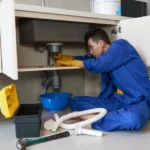Ever noticed a weird musty smell in your home but can’t figure out where it’s coming from? Or maybe your water bill suddenly shot up for no reason? If so, you might have a water leak hiding inside your walls. And trust us, you don’t want to ignore it.
Water leaks in walls are sneaky. They start small, but if left unchecked, they can lead to mold, structural damage, and even health problems. But if you know what to look for you can catch them early. Let’s talk about how to detect water leaks in walls before they turn into a nightmare.
Signs You Might Have a Water Leak in Your Wall
You don’t have to tear down walls to find a leak. Here are some clear signs that something’s wrong:
-
Strange Smells
That funky, damp odor you can’t quite place? It’s not just unpleasant – it’s often the first clue you’ve got a hidden water leak. When water seeps into walls, it creates the perfect breeding ground for mold and mildew. These little invaders release that distinct musty smell as they grow. If your nose wrinkles every time you walk into a certain room, don’t ignore it. That stench is literally a warning telling you something’s wrong behind those walls.
-
Stains or Discoloration
Ever noticed mysterious yellow or brown patches appearing on your walls or ceiling? Those ugly stains aren’t just cosmetic issues – they’re like bruises showing where water is pooling inside. Paint or wallpaper that’s peeling or bubbling without reason is another dead giveaway. Water weakens the adhesive and causes finishes to separate from the wall. If your home is suddenly developing these “age spots,” it’s time to play detective.
-
Warped or Bubbling Walls
Drywall acts like a sponge when water gets behind it – it soaks up moisture and starts to swell. You might notice subtle bulges or bubbles forming under the paint. In more severe cases, walls can develop visible waves or curves where they should be flat. Wood trim and baseboards aren’t immune either – they’ll start to warp or feel suspiciously soft to the touch. If your walls are looking less like smooth surfaces and more like topographic maps, water damage is likely the issue.
-
Higher Water Bills
That sudden spike in your water bill when your usage habits haven’t changed? It’s not the utility company messing up – it’s probably water escaping where it shouldn’t. Even small leaks can waste hundreds of gallons monthly. A tiny drip from a pinhole leak adds up to about 20 gallons a day. If your bill’s climbing for no apparent reason, it’s worth investigating before you literally flush money down the drain.
-
Sounds of Running Water
Your house should be quiet when all faucets are off. If you’re hearing mysterious dripping or the faint sound of water moving through pipes when everything’s supposed to be dry, that’s your home’s version of crying for help. Try listening at night when household noise is minimal – press your ear against walls near plumbing lines. That faint drip… drip… Do you hear? That’s the sound of your money and your home’s integrity slowly draining away.
-
Mold Growth
Those black or green splotches creeping along your baseboards or in room corners aren’t just unsightly – they’re health hazards. Mold spores grow in damp environments, and they can start growing within 24-48 hours of water exposure. What begins as small dots can quickly spread into large colonies if the moisture source isn’t addressed. Beyond being gross, mold can trigger allergies and respiratory issues. If you’re seeing these unwelcome “decorations,” there’s definitely unwanted water somewhere it shouldn’t be.
If you notice any of these, it’s time for water leak detection.
How to Detect Water Leaks in Walls (Without Tearing Them Down)?
Okay, so you think there’s a leak? Now what? You don’t have to call a plumber right away. Try these simple checks first:
-
The Meter Test
- Turn off all water in the house (no faucets, showers, or appliances running).
- Check your water meter. If it’s still moving, you’ve got a leak somewhere.
-
The Toilet Paper Trick
- Dry a section of the wall with a towel.
- Press a piece of toilet paper against it. If it gets wet quickly, there’s moisture inside.
-
Infrared Thermometer (If You Have One)
- Cool spots on walls can mean water is trapped inside.
- A cheap IR thermometer from a hardware store can help find these spots.
-
Listen for Drips
- At night, when the house is quiet, press your ear against the wall.
- A faint dripping sound could mean a pipe is leaking.
-
Check for Soft Spots
- Gently press on the wall. If it feels spongy, water has weakened it.
These tricks can help you confirm a leak before calling in the pros.
What to Do If You Find a Leak?
If you’ve confirmed a leak, don’t panic. Here’s what to do next:
1. Turn Off the Water:
Locate your main shut-off valve and stop the flow to prevent more damage.
2. Call a Professional:
Some leaks are easy to fix, but others need expert help.
3. Dry the Area:
Use fans or a dehumidifier to prevent mold growth.
4. Check for Mold:
If you see or smell mold, get it treated ASAP.
Ignoring a leak can cost thousands in repairs later. Acting fast saves money and stress.
How to Prevent Future Leaks?
The best way to deal with leaks? Stop them before they start. Here’s how:
- Inspect Pipes Regularly: Look for rust, cracks, or moisture around pipes.
- Fix Drips Immediately: A small drip today can become a big leak tomorrow.
- Monitor Water Pressure: Too much pressure strains pipes and causes leaks.
- Insulate Pipes in Cold Areas: Frozen pipes burst easily in winter.
- Replace Old Plumbing: If your pipes are over 20 years old, consider an upgrade.
A little prevention goes a long way.
Also Read: How to prevent clogged drains in NYC homes & apartments
Why You Should Care About Hidden Water Leaks?
Here’s why hidden leaks are a big deal:
- They waste money: A small leak can add hundreds to your water bill over time.
- They damage your home: Rotting wood, crumbling drywall, and weakened structures.
- They cause mold: Mold loves damp places, and it can make you sick.
- They lower home value: Undetected leaks can lead to expensive repairs that buyers will notice.
The sooner you find a leak, the less damage it’ll do. So, how do you know if you have one?
When to Call the Pros?
Some leaks are easy to fix, but others? Not so much. Here’s when you should call a plumber:
- You can’t find the source: If the leak is hidden deep in the walls.
- There’s major damage: Sagging ceilings, large stains, or mold patches.
- You’re not comfortable DIYing: Plumbing mistakes can make things worse.
Don’t Stress – UnClog NYC Handle This Stuff Daily
At UnClog NYC, we’ve seen it all, from small drips to full-blown pipe disasters. If you’re in NYC and think you’ve got a hidden leak, we can help. Our team uses advanced tools to find leaks without unnecessary damage, and we’ll fix them fast.
Water leaks in walls don’t go away on their own. The longer you wait, the worse and more expensive it gets. If you suspect a leak, don’t ignore it. Check the signs, test the walls, and if you need help, reach out before the damage spreads. Contact UnClog NYC today, and let’s get it fixed before it’s too late.




